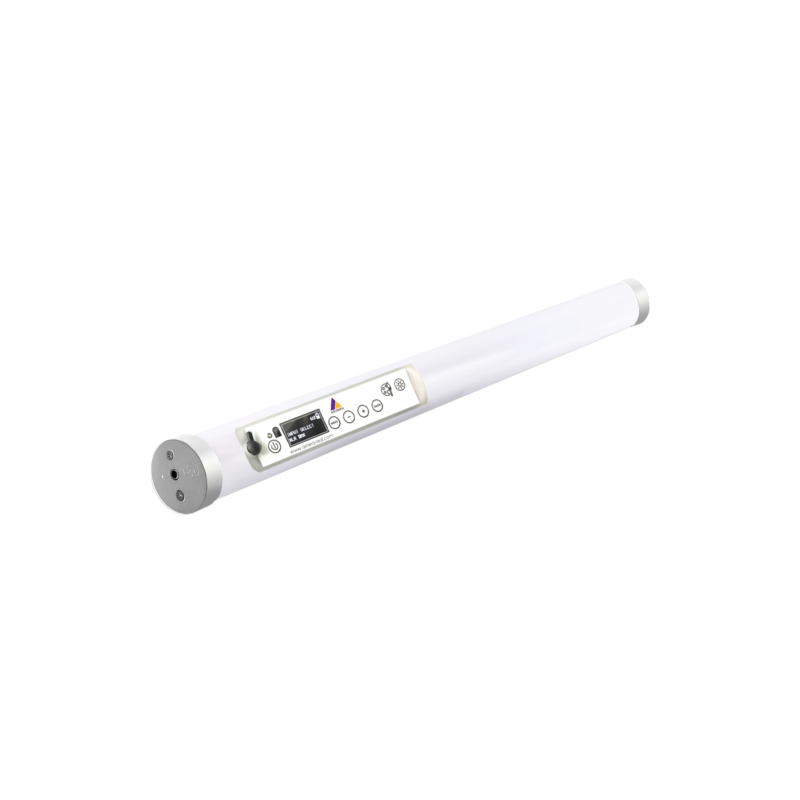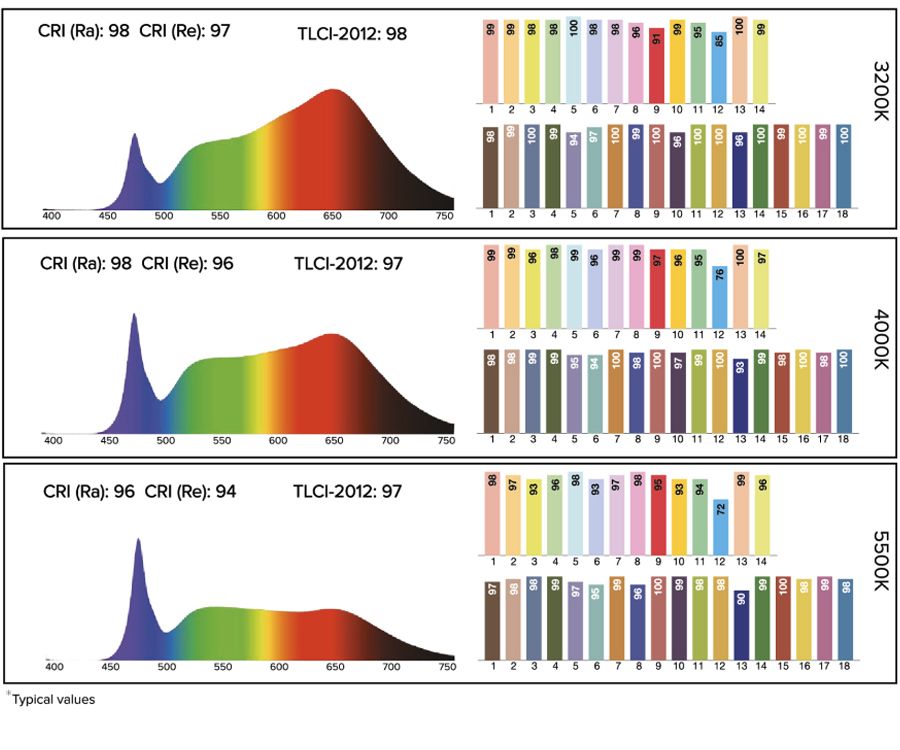由于组件短缺,Astera对Helios Tube进行了内部升级。2021年10月以后生产的设备具有内置的BTB功能。型号名称升级为FP2-BTB。

注意事项
技术规格
型号 | FP2 | FP2-BTB |
|---|---|---|
Titan LED引擎集成 | Titan LED引擎集成 | Titan LED引擎集成 |
颜色 | RGBMintAmber | RGBMintAmber |
LED总功率 | 36 W | 36 W |
LED额定功率 | 24 W | 24 W |
Luminous Flux 3200K | 1 285 Lumens | 1 285 Lumens |
Luminous Flux 4000K | 1 340 Lumens | 1 340 Lumens |
光照强度(3200K,距离1M) | 360 Lux | 360 Lux |
光照强度(4000K,距离1M) | 393 Lux | 393 Lux |
显色指数 (CRI(Ra)/TLCI 3200-6500K*) | ≥96 | ≥96 |
出光角度 | 135° x 115° | 135° x 115° |
出光角度(IES规范) | 135° x 115° | 135° x 115° |
频闪效果 | 0 – 25 Hertz | 0 – 25 Hertz |
像素 | 8 | 8 |
电池运行时间 | 长达20小时 | 长达20小时 |
电池寿命 | 充放电循环300次后剩余70%电力 | 充放电循环300次后剩余70%电力 |
充电时间(标称) | 3小时 | 3小时 |
输入电压 | 24 VDC – 1.25 A | 24 VDC – 1.25 A |
DC连接器 | 5.5 mm x 2.1 mm | 5.5 mm x 2.1 mm |
有线DMX | 是 (via FP1-PWB / FP3-DTL / PWB-2-86) | 是 (via FP1-PWB / FP3-DTL / PWB-2-86) |
CRMX接收器 | 内置 | 内置 |
蓝牙网桥系统(BTB) | 无 | 是 |
无线协议 | 支持CRMX,UHF | CRMX,UHF,蓝牙,无线网络连接 |
无线通信距离 | CRMX/UHF 最远可达300米/330码 | CRMX/UHF 最远可达300米/330码 蓝牙最远可达3米/3.3码 |
红外线控制 | 支持 | 是 |
外壳材料 | 聚碳酸酯,金属端盖 | 聚碳酸酯,金属端盖 |
IP等级 | IP65(仅适用于带FP1-SP时) | IP65(仅适用于带FP1-SP时) |
环境工作温度 | 0 – 40 °C / 32 – 104 °F | 0 – 40 °C / 32 – 104 °F |
产品重量(克/磅) | 0.765 kg / 1.68 lbs | 0.765 kg / 1.68 lbs |
尺寸 (L x Ø) | 550 mm x Ø 43 mm / 21.7" x Ø 1.7" | 550 mm x Ø 43 mm / 21.7" x Ø 1.7" |
安装选项 | 2个M5螺纹,2个支架(带2个M5和1个1/4\"-20UNC螺纹),1个地龟脚架 | 2个M5螺纹,2个支架(带2个M5和1个1/4\"-20UNC螺纹),1个地龟脚架 |
All specifications provided are typical values and may be subject to change without prior notice.
盒子里有什么?
- 1 x Helios 灯管 (FP2-BTB)
- 2 x 灯管支撑架(AX1-H)
- 1 x 地龟脚架(AX1-STD)
- 2 x 吊环螺栓(FP1-EBLT)
- 1 x DC插座防水塞 (FP1/2-SP)
经典光谱
RF射频特性
用于FP2 Helios灯管
Wireless Modules | Modulation | ERP (Transmitter) | Channel Count |
|---|---|---|---|
EU: UHF***(863-870MHz) | FHSS | <25mW | 47 |
USA: UHF (917-922.20MHz) | FHSSFHSS | <25mW | 53 |
AUS: UHF (922.30-927.50MHz) | FHSS | <25mW | 53 |
SGP: UHF (920.50-924.50MHz) | FHSS | <25mW | 41 |
KOR: UHF (917.9-921.5MHz) | FHSS | <25mW | 10 |
RUS: UHF (868.75-869.12MHz) | FHSS | <25mW | 6 |
JPN: UHF (922.80-926.40MHz) | FHSS | <25mW | 19 |
CRMX (2402-2480MHz) | FHSS | – | 79 |
***General allocation of frequencies for use by short-range radio applications Spectrum usage regulations:
Frequency range in MHz1) | Maximum equivalent radiant power (ERP) | Additional parameters / frequency access and interference mitigation techniques |
|---|---|---|
865 – 868 | 25 mW | Requirements for frequency access and mitigation techniques3) Alternatively, a maximum duty cycle2) of 1% can be used. |
868,0 – 868,6 | 25 mW | Requirements for frequency access and mitigation techniques3) Alternatively, a maximum duty cycle2) of 1% can be used. |
868,7 – 869,2 | 25 mW | Requirements for frequency access and mitigation techniques3) Alternatively, a maximum duty cycle2) of 0.1% can be used. |
869,40 – 869,65 | 500 mW | Requirements for frequency access and mitigation techniques3) Alternatively, a maximum duty cycle2) of 10% can be used. |
869,7 – 870,0 | 25 mW | Requirements for frequency access and mitigation techniques3) Alternatively, a maximum duty cycle2) of 1% can be used. |
1) The use of adjacent frequency bands within this table as a single frequency band is permitted, provided that the specific conditions for each of these adjacent frequency bands are met. 2) „duty cycle“ means the ratio of Σ(Ton)/(Tobs) expressed as a percentage, where ‚Ton‘ is the ‚on-time‘ of a single transmitting device and ‚Tobs‘ is the observation period Ton is measured in an observation frequency band (Fobs). Unless otherwise specified in this general allocation, Tobs is a continuous period of one hour and Fobs is the applicable frequency band in this general allocation (table). 3) Frequency access and interference mitigation techniques shall be used whose performance level at least meets the essential requirements of Directive 2014/53/EU or the Radio Equipment Act (FuAG). Where relevant techniques are described in harmonised standards, the references of which have been published in the Official Journal of the European Union pursuant to Directive 2014/53/EU, or parts thereof, performance shall be ensured which is at least equivalent to those techniques.
用于FP2-BTB Helios灯管
Wireless Modules | Modulation | ERP (Transmitter) | Channel Count |
|---|---|---|---|
EU: UHF***(863-870MHz) | FHSS | <25mW | 47 |
USA: UHF (917-922.20MHz) | FHSS | <25mW | 53 |
AUS: UHF (922.30-927.50MHz) | FHSS | <25mW | 53 |
SGP: UHF (920.50-924.50MHz) | FHSS | <25mW | 41 |
KOR: UHF (917.9-921.5MHz) | FHSS | <25mW | 10 |
RUS: UHF (868.75-869.12MHz) | FHSS | <25mW | 6 |
JPN: UHF (922.80-926.40MHz) | FHSS | <25mW | 19 |
CRMX (2402-2480MHz) | FHSS | – | 79 |
Bluetooth 5.0 LE (2402-2480MHz) | FHSS | 10mW (BLE) | 40 |
WiFi (2412-2472MHz) | DSSS, OFDM | <100mW | 13 |
***General allocation of frequencies for use by short-range radio applications Spectrum usage regulations:
Frequency range in MHz1) | Maximum equivalent radiant power (ERP) | Additional parameters / frequency access and interference mitigation techniques |
|---|---|---|
865 – 868 | 25 mW | Requirements for frequency access and mitigation techniques3) Alternatively, a maximum duty cycle2) of 1% can be used. |
868,0 – 868,6 | 25 mW | Requirements for frequency access and mitigation techniques3) Alternatively, a maximum duty cycle2) of 1% can be used. |
868,7 – 869,2 | 25 mW | Requirements for frequency access and mitigation techniques3) Alternatively, a maximum duty cycle2) of 0.1% can be used. |
869,40 – 869,65 | 500 mW | Requirements for frequency access and mitigation techniques3) Alternatively, a maximum duty cycle2) of 10% can be used. |
869,7 – 870,0 | 25 mW | Requirements for frequency access and mitigation techniques3) Alternatively, a maximum duty cycle2) of 1% can be used. |
1) The use of adjacent frequency bands within this table as a single frequency band is permitted, provided that the specific conditions for each of these adjacent frequency bands are met. 2) „duty cycle“ means the ratio of Σ(Ton)/(Tobs) expressed as a percentage, where ‚Ton‘ is the ‚on-time‘ of a single transmitting device and ‚Tobs‘ is the observation period Ton is measured in an observation frequency band (Fobs). Unless otherwise specified in this general allocation, Tobs is a continuous period of one hour and Fobs is the applicable frequency band in this general allocation (table). 3) Frequency access and interference mitigation techniques shall be used whose performance level at least meets the essential requirements of Directive 2014/53/EU or the Radio Equipment Act (FuAG). Where relevant techniques are described in harmonised standards, the references of which have been published in the Official Journal of the European Union pursuant to Directive 2014/53/EU, or parts thereof, performance shall be ensured which is at least equivalent to those techniques.
